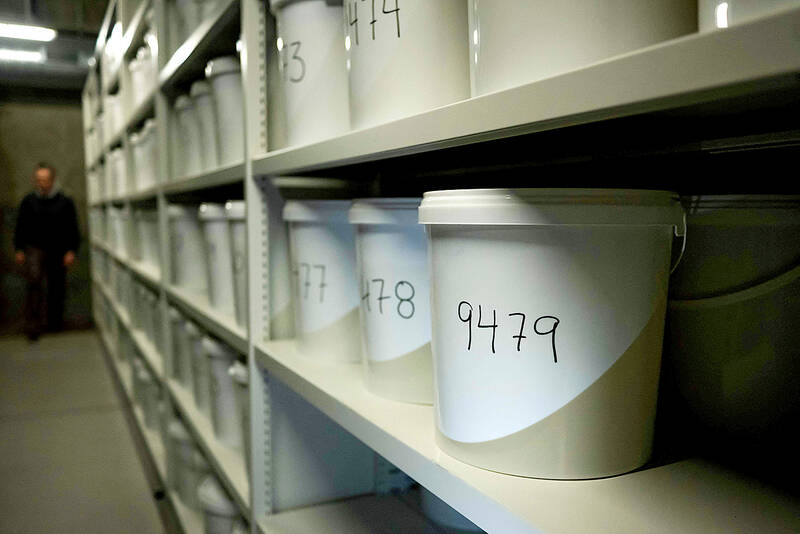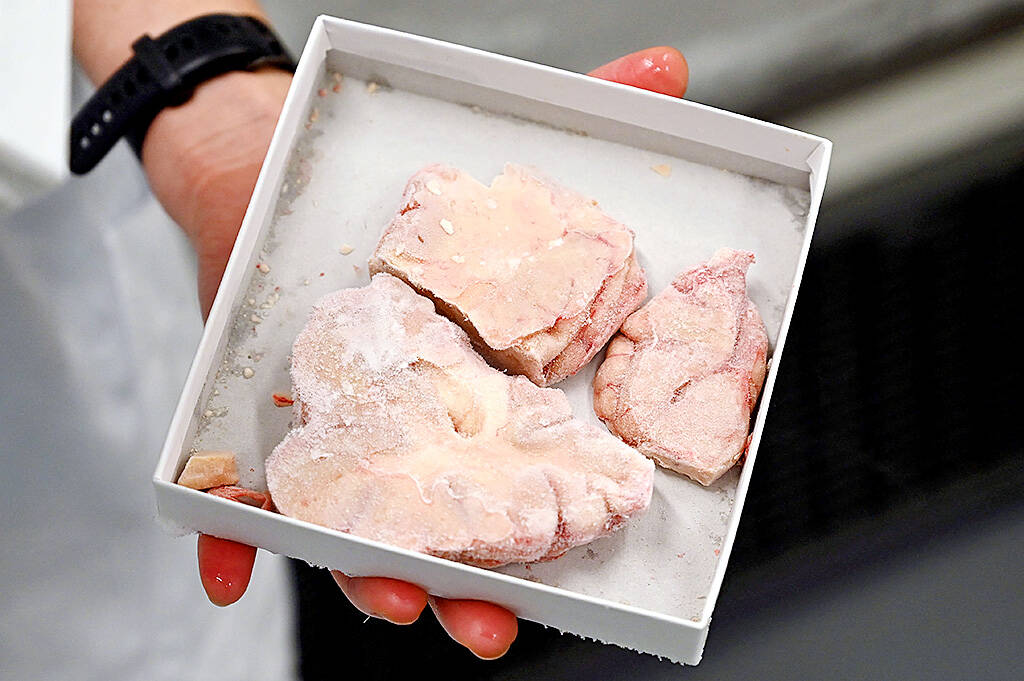Countless shelves line the walls of a basement at Denmark’s University of Odense, holding what is thought to be the world’s largest collection of brains.
There are 9,479 of the organs, all removed from the corpses of mental health patients over the course of four decades until the 1980s.
Preserved in formalin in large white buckets labeled with numbers, the collection was the life’s work of prominent Danish psychiatrist Erik Stromgren.

Photo: AFP
Begun in 1945, it was a “kind of experimental research,” said Jesper Vaczy Kragh, an expert in the history of psychiatry.
Stromgren and his colleagues believed “maybe they could find out something about where mental illnesses were localized, or they thought they might find the answers in those brains.”
The brains were collected after autopsies had been conducted on the bodies of people committed to psychiatric institutes across Denmark.

Photo: AFP
Neither the deceased nor their families were ever asked permission.
“These were state mental hospitals and there were no people from the outside who were asking questions about what went on in these state institutions,” he said.
At the time, patients’ rights were not a primary concern.
On the contrary, society believed it needed to be protected from these people, the researcher from the University of Copenhagen said.
Between 1929 and 1967, the law required people committed to mental institutions to be sterilized.
Up until 1989, they had to get a special exemption in order to be allowed to marry.
Denmark considered “mentally ill” people, as they were called at the time, “a burden to society (and believed that) if we let them have children, if we let them loose... they will cause all kinds of trouble,” Vaczy Kragh said.
Back then, every Dane who died was autopsied, said pathologist Martin Wirenfeldt Nielsen, the director of the collection.
“It was just part of the culture back then, an autopsy was just another hospital procedure,” Nielsen said.
The evolution of post-mortem procedures and growing awareness of patients’ rights heralded the end of new additions to the collection in 1982.
A long and heated debate then ensued on what to do with it.
Denmark’s state ethics council ultimately ruled it should be preserved and used for scientific research.
UNLOCKING HIDDEN SECRETS
The collection, long housed in Aarhus in western Denmark, was moved to Odense in 2018.
Research on the collection has over the years covered a wide range of illnesses, including dementia, schizophrenia, bipolar disorder and depression.
“The debate has basically settled down, and (now people) say ‘okay, this is very impressive and useful scientific research if you want to know more about mental disease,’” the collection’s director said.
Some of the brains belonged to people who suffered from both mental health issues and brain illnesses.
“Because many of these patients were admitted for maybe half their life, or even their entire life, they would also have had other brain diseases, such as a stroke, epilepsy or brain tumors,” he added.
Four research projects are currently using the collection.
“If it’s not used, it does no good,” says the former head of the country’s mental health association, Knud Kristensen.
“Now we have it, we should actually use it,” he said, complaining about a lack of resources to fund research.
Neurobiologist Susana Aznar, a Parkinson’s expert working at a Copenhagen research hospital, is using the collection as part of her team’s research project.
She said the brains were unique in that they enable scientists to see the effects of modern treatments.
“They were not treated with the treatments that we have now,” she said.
The brains of patients nowadays may have been altered by the treatments they have received.
When Aznar’s team compares these with the brains from the collection, “we can see whether these changes could be associated with the treatments,” she said.

May 11 to May 18 The original Taichung Railway Station was long thought to have been completely razed. Opening on May 15, 1905, the one-story wooden structure soon outgrew its purpose and was replaced in 1917 by a grandiose, Western-style station. During construction on the third-generation station in 2017, workers discovered the service pit for the original station’s locomotive depot. A year later, a small wooden building on site was determined by historians to be the first stationmaster’s office, built around 1908. With these findings, the Taichung Railway Station Cultural Park now boasts that it has

The latest Formosa poll released at the end of last month shows confidence in President William Lai (賴清德) plunged 8.1 percent, while satisfaction with the Lai administration fared worse with a drop of 8.5 percent. Those lacking confidence in Lai jumped by 6 percent and dissatisfaction in his administration spiked up 6.7 percent. Confidence in Lai is still strong at 48.6 percent, compared to 43 percent lacking confidence — but this is his worst result overall since he took office. For the first time, dissatisfaction with his administration surpassed satisfaction, 47.3 to 47.1 percent. Though statistically a tie, for most

In February of this year the Taipei Times reported on the visit of Lienchiang County Commissioner Wang Chung-ming (王忠銘) of the Chinese Nationalist Party (KMT) and a delegation to a lantern festival in Fuzhou’s Mawei District in Fujian Province. “Today, Mawei and Matsu jointly marked the lantern festival,” Wang was quoted as saying, adding that both sides “being of one people,” is a cause for joy. Wang was passing around a common claim of officials of the People’s Republic of China (PRC) and the PRC’s allies and supporters in Taiwan — KMT and the Taiwan People’s Party — and elsewhere: Taiwan and

Six weeks before I embarked on a research mission in Kyoto, I was sitting alone at a bar counter in Melbourne. Next to me, a woman was bragging loudly to a friend: She, too, was heading to Kyoto, I quickly discerned. Except her trip was in four months. And she’d just pulled an all-nighter booking restaurant reservations. As I snooped on the conversation, I broke out in a sweat, panicking because I’d yet to secure a single table. Then I remembered: Eating well in Japan is absolutely not something to lose sleep over. It’s true that the best-known institutions book up faster